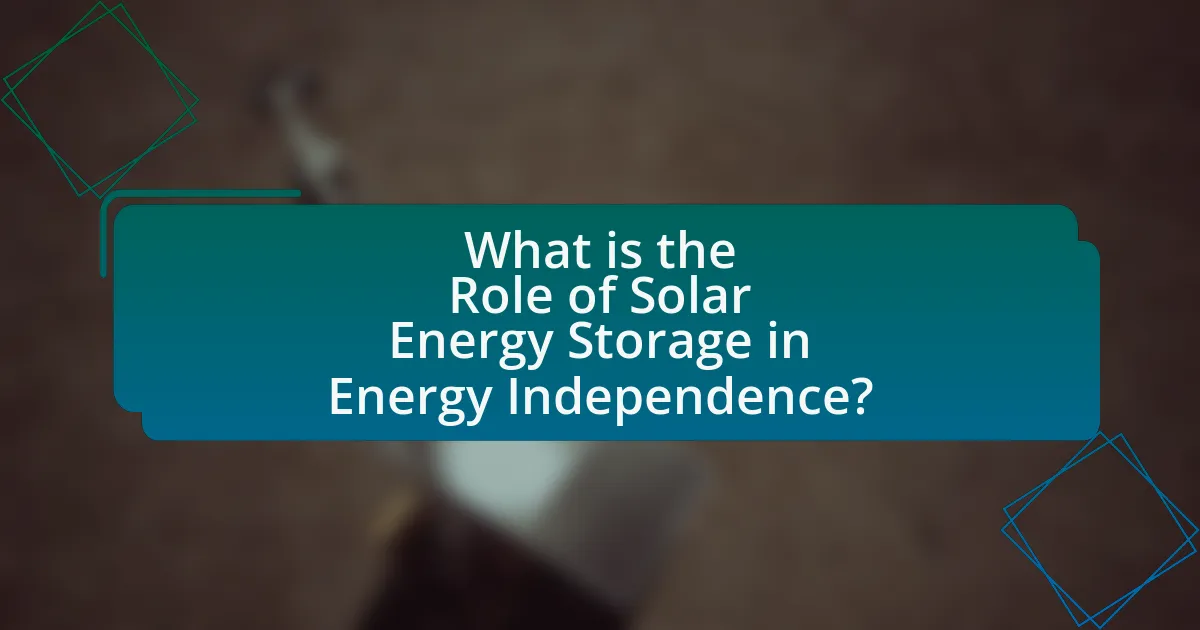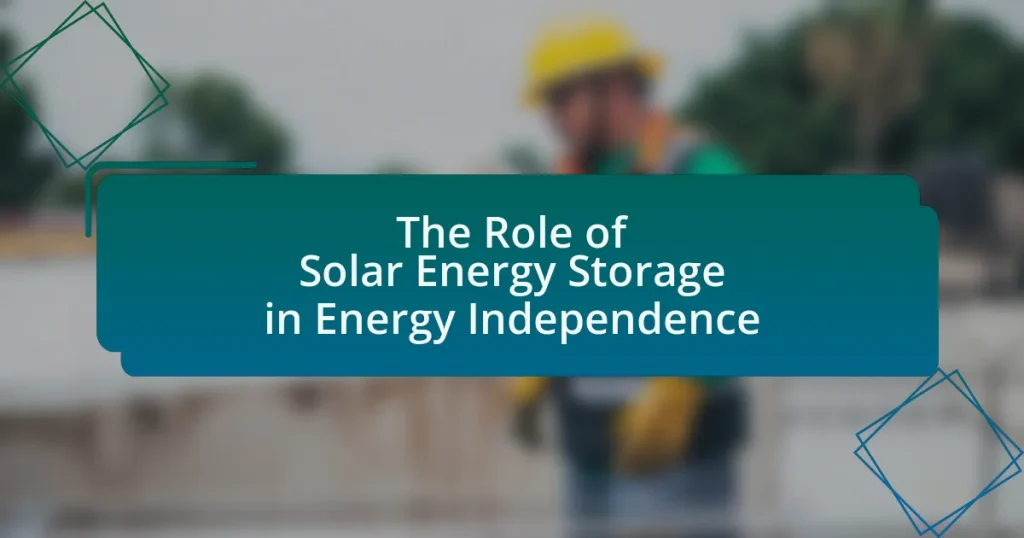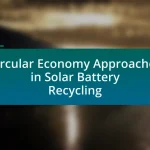Solar energy storage is a pivotal component in achieving energy independence, facilitating the efficient use of renewable energy by capturing and storing excess solar power generated during peak sunlight hours. This technology reduces reliance on fossil fuels, enhances grid stability, and allows individuals and communities to utilize their own electricity during low sunlight periods or high demand. Key technologies such as lithium-ion batteries, flow batteries, and thermal energy storage systems play significant roles in this process, while challenges like high costs and regulatory issues impact widespread adoption. The article explores the economic benefits of energy independence, its importance for national security, and best practices for optimizing solar energy storage systems.
What is the Role of Solar Energy Storage in Energy Independence?


Solar energy storage plays a crucial role in achieving energy independence by enabling the efficient use of renewable energy. It allows for the capture and storage of excess solar energy generated during peak sunlight hours, which can then be utilized during periods of low sunlight or high demand. This capability reduces reliance on fossil fuels and enhances grid stability, as stored energy can be dispatched when needed, thus minimizing the need for imported energy sources. According to the U.S. Department of Energy, energy storage systems can significantly increase the penetration of solar energy into the grid, facilitating a transition to a more sustainable and self-sufficient energy landscape.
How does solar energy storage contribute to energy independence?
Solar energy storage enhances energy independence by allowing individuals and communities to store excess solar power for later use, reducing reliance on external energy sources. This capability enables users to generate and utilize their own electricity, particularly during peak demand times or outages, thereby decreasing dependence on the grid and fossil fuels. For instance, a study by the National Renewable Energy Laboratory found that integrating energy storage with solar systems can significantly lower energy costs and increase resilience against energy supply disruptions.
What are the key technologies involved in solar energy storage?
The key technologies involved in solar energy storage include lithium-ion batteries, flow batteries, and thermal energy storage systems. Lithium-ion batteries are widely used due to their high energy density and efficiency, making them suitable for residential and commercial applications. Flow batteries, which utilize liquid electrolytes, offer scalability and longer discharge times, ideal for larger energy storage needs. Thermal energy storage systems, such as molten salt storage, capture excess heat generated by solar thermal plants, allowing for energy release when sunlight is not available. These technologies collectively enhance the reliability and efficiency of solar energy systems, supporting energy independence by enabling the storage and use of solar power during non-sunny periods.
How do these technologies enhance energy independence?
Solar energy storage technologies enhance energy independence by enabling the efficient capture and utilization of solar power, reducing reliance on external energy sources. These technologies, such as batteries and thermal storage systems, allow for the storage of excess solar energy generated during peak sunlight hours, which can then be used during periods of low sunlight or high demand. For instance, according to the U.S. Department of Energy, the integration of solar energy storage can lead to a 30% reduction in energy imports for regions heavily reliant on fossil fuels. This capability not only stabilizes energy supply but also promotes local energy production, further contributing to energy independence.
Why is energy independence important for nations?
Energy independence is crucial for nations as it enhances their economic stability and security. By reducing reliance on foreign energy sources, countries can protect themselves from price volatility and supply disruptions, which can arise from geopolitical tensions or natural disasters. For instance, the U.S. increased its energy independence significantly between 2008 and 2019, leading to a reduction in oil imports by over 50%, which bolstered its economic resilience. Furthermore, energy independence allows nations to invest in domestic energy production, fostering job creation and technological innovation, particularly in renewable energy sectors like solar energy. This shift not only contributes to environmental sustainability but also strengthens national security by minimizing vulnerabilities associated with energy supply chains.
What are the economic benefits of energy independence?
Energy independence provides significant economic benefits, including reduced energy costs, enhanced energy security, and job creation. By relying on domestic energy sources, countries can decrease their vulnerability to global energy price fluctuations, which can lead to more stable and predictable energy expenses for consumers and businesses. For instance, the U.S. Energy Information Administration reported that increased domestic oil production has contributed to lower gasoline prices, saving consumers billions annually. Additionally, energy independence fosters job creation in renewable energy sectors; the Solar Foundation’s National Solar Jobs Census indicated that the solar industry employed over 250,000 workers in the U.S. in 2019, showcasing the potential for economic growth through local energy initiatives.
How does energy independence impact national security?
Energy independence enhances national security by reducing reliance on foreign energy sources, which can be vulnerable to geopolitical tensions and supply disruptions. When a nation produces its own energy, it mitigates risks associated with energy shortages caused by conflicts, trade disputes, or sanctions. For instance, the United States’ increased domestic oil and natural gas production has been linked to a decrease in energy imports, thereby strengthening its strategic autonomy and resilience against external pressures. This shift not only bolsters economic stability but also allows for more effective military and diplomatic strategies, as nations are less beholden to foreign energy suppliers.
What challenges does solar energy storage face in promoting energy independence?
Solar energy storage faces significant challenges in promoting energy independence, primarily due to high costs, limited storage capacity, and technological constraints. The initial investment for solar storage systems, such as batteries, can be prohibitively expensive, often deterring widespread adoption. For instance, the average cost of lithium-ion batteries, commonly used for solar energy storage, was around $400 per kilowatt-hour in 2020, which can limit accessibility for many consumers.
Additionally, current storage technologies often have limited capacity and efficiency, meaning they can only store a fraction of the energy generated during peak sunlight hours. This limitation can lead to energy shortages during periods of high demand or low sunlight, undermining the reliability of solar energy as a primary power source. Furthermore, the lifespan of storage systems can vary, with many batteries requiring replacement every 5 to 15 years, adding to long-term costs and complicating energy independence efforts.
Lastly, the integration of solar energy storage into existing energy grids presents logistical and regulatory challenges, as many grids are not designed to accommodate decentralized energy sources. These factors collectively hinder the ability of solar energy storage to effectively promote energy independence.
What are the technical limitations of current solar energy storage systems?
Current solar energy storage systems face several technical limitations, including limited energy density, high costs, and degradation over time. Energy density in lithium-ion batteries, commonly used for solar storage, is around 150-250 Wh/kg, which restricts the amount of energy that can be stored in a given volume or weight. The high initial investment for these systems can exceed $1,000 per kWh, making them less accessible for widespread adoption. Additionally, battery performance typically degrades by about 20% after 5 years of use, leading to reduced efficiency and increased replacement costs. These factors collectively hinder the effectiveness and scalability of solar energy storage solutions.
How do regulatory and policy issues affect solar energy storage adoption?
Regulatory and policy issues significantly influence solar energy storage adoption by establishing the framework for incentives, standards, and market access. For instance, government policies such as tax credits, rebates, and renewable energy mandates can enhance the financial viability of solar storage systems, encouraging more consumers and businesses to invest. According to the Solar Energy Industries Association, states with supportive policies have seen a marked increase in solar installations, demonstrating that favorable regulations can drive market growth. Conversely, restrictive policies or lack of clear regulations can hinder adoption by creating uncertainty and increasing costs, as seen in regions with limited incentives or complex permitting processes. Thus, the regulatory landscape directly impacts the pace and scale of solar energy storage integration into the energy market.
How can solar energy storage systems be integrated into existing energy grids?
Solar energy storage systems can be integrated into existing energy grids by utilizing technologies such as battery storage, pumped hydro storage, and thermal storage to manage energy supply and demand effectively. These systems allow for the capture of excess solar energy generated during peak sunlight hours, which can then be released during periods of high demand or low generation, thus stabilizing the grid. For instance, according to the U.S. Department of Energy, the deployment of grid-scale battery storage has increased significantly, with over 3,000 megawatts installed by 2020, demonstrating the feasibility and effectiveness of integrating solar storage into the grid. This integration enhances grid reliability, reduces reliance on fossil fuels, and supports the transition to renewable energy sources.
What are the best practices for implementing solar energy storage solutions?
The best practices for implementing solar energy storage solutions include selecting the appropriate battery technology, optimizing system sizing, ensuring proper installation, and integrating smart management systems. Choosing the right battery technology, such as lithium-ion or flow batteries, is crucial as it affects efficiency, lifespan, and cost. Optimizing system sizing involves accurately assessing energy needs and solar generation to ensure the storage capacity meets demand without excessive costs. Proper installation by certified professionals ensures safety and compliance with regulations, while integrating smart management systems allows for real-time monitoring and efficient energy use. These practices enhance the reliability and effectiveness of solar energy storage, contributing to energy independence.
How can individuals and businesses optimize their solar energy storage systems?
Individuals and businesses can optimize their solar energy storage systems by selecting high-efficiency batteries, implementing smart energy management systems, and conducting regular maintenance. High-efficiency batteries, such as lithium-ion, offer better energy density and longer life cycles, which enhance storage capacity and reduce replacement costs. Smart energy management systems allow users to monitor energy consumption and production in real-time, enabling them to make informed decisions about energy usage and storage. Regular maintenance, including checking battery health and system performance, ensures optimal operation and longevity of the storage system. These strategies collectively improve the efficiency and effectiveness of solar energy storage, contributing to greater energy independence.
What common mistakes should be avoided when adopting solar energy storage?
Common mistakes to avoid when adopting solar energy storage include underestimating energy needs, neglecting system compatibility, and overlooking maintenance requirements. Underestimating energy needs can lead to insufficient storage capacity, resulting in inadequate power supply during peak usage times. Neglecting system compatibility may cause inefficiencies or system failures, as not all solar panels and storage systems work well together. Overlooking maintenance requirements can lead to decreased performance and lifespan of the storage system, ultimately increasing costs. These mistakes can hinder the effectiveness of solar energy storage in achieving energy independence.


